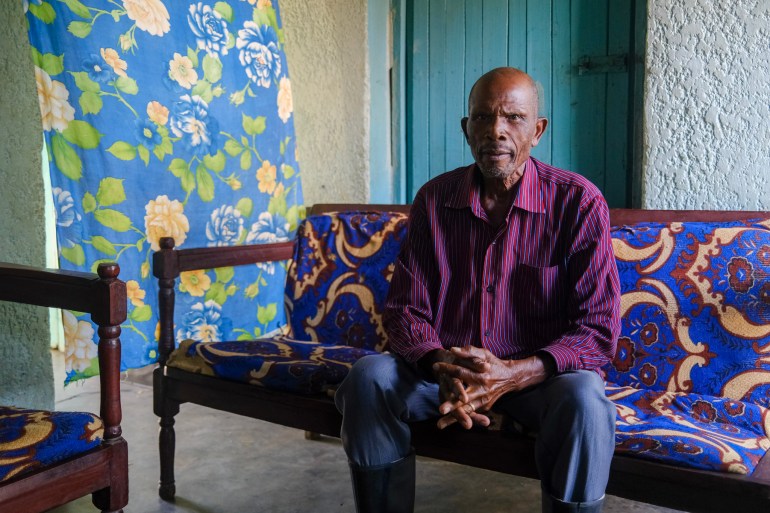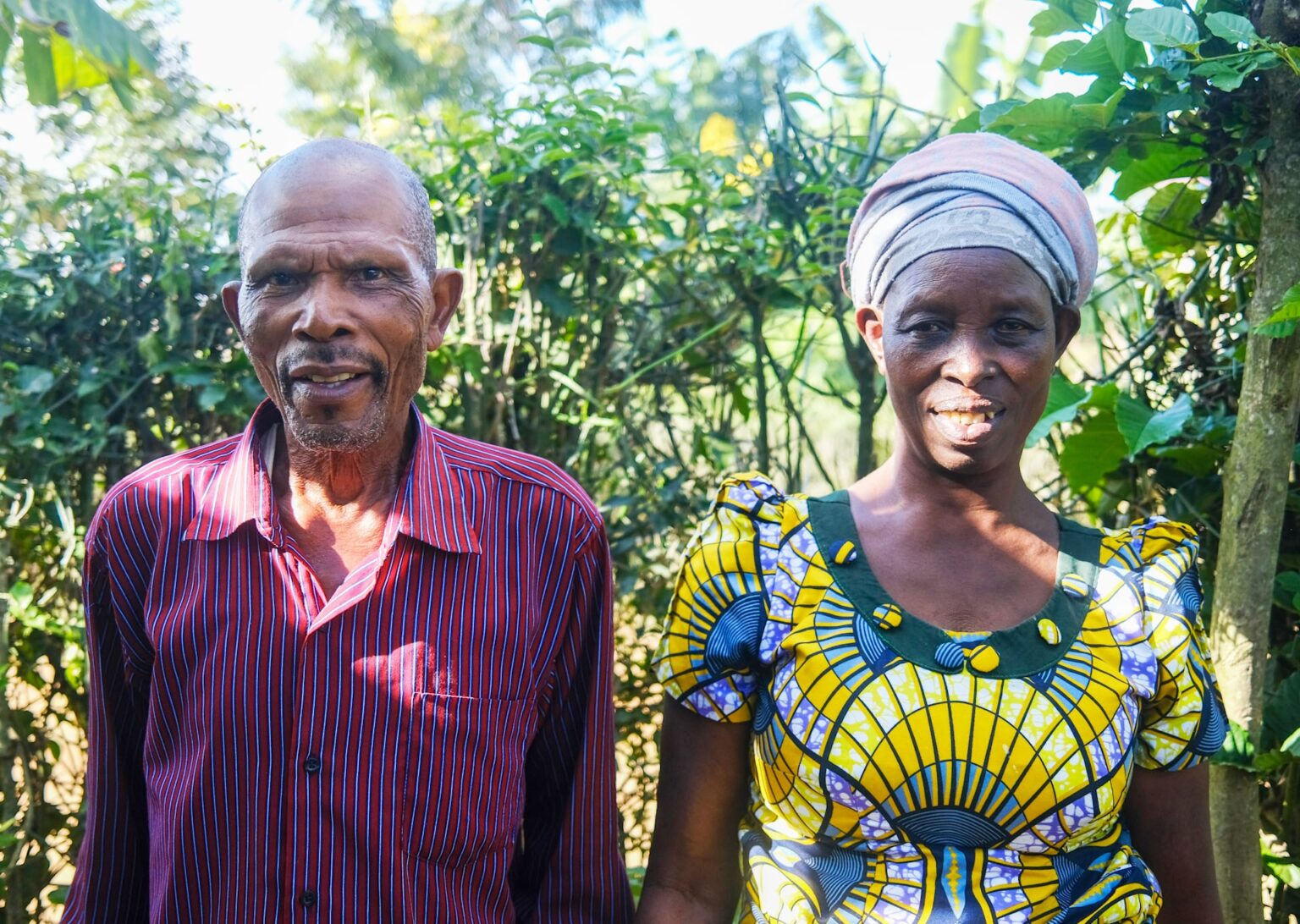Mbyo/Kigali, Rwanda – Mukaremera Laurence gazed on the floor as Nkundiye Thacien spoke about how he used a machete to kill her husband 30 years in the past.
The three of them had been neighbours and lifelong pals, residing collectively within the Rwandan village of Mbyo. But then, in 1994, Thacien obtained orders to kill.
“It was an order and if you didn’t obey they threatened to kill your family,” Thacien advised Al Jazeera, “so I felt like I had to do it.”
He speaks about one of many twentieth century’s most macabre occasions, when the bulk Hutu group he belonged to, which dominated Rwanda on the time, started a marketing campaign of mass killing towards the Tutsis – the minority ethnic group to which Laurence’s husband belonged.
More than 800,000 individuals – by some estimates, one million – died throughout 100 days by the hands of machete-wielding Hutus. More than 250,000 ladies have been focused with sexual violence, based on the United Nations.
Now, Laurence and Thacien stay as neighbours in Mbyo, a village that has turned from a killing website to a spot training resilience and unity. It is one among six reconciliation villages in Rwanda the place perpetrators and survivors of the 1994 genocide towards the Tutsis stay collectively and try and reconcile their previous.
“We can’t forget; it’s impossible to forget,” mentioned Laurence. “We live in peace now, but we remember it and always will.”
While their reconciliation story is seemingly one among success, regardless of criticism of it being synthetic, Rwandans proceed to battle with the legacy of the genocide. Many survivors have discovered solace in studying the reality about how their family members have been murdered and from apologies from their killers. Others haven’t discovered such closure, as new mass graves proceed to be found and killers’ identities proceed to be uncovered.

Orders to kill
Ethnic violence had been effervescent in Rwanda for many years earlier than April 6, 1994, but it surely was on that day {that a} aircraft carrying then-President Juvenal Habyarimana and Burundian President Cyprien Ntaryamira, bot was shot down over Kigali. The demise of the 2 presidents, who have been each Hutu, led Hutu extremists guilty the Tutsi-led Rwandan Patriotic Front (RPF), a insurgent group helmed by present president Paul Kagame, who had been combating towards the ruling Hutus since they took energy in 1979. The RPF’s place was that the aircraft had been shot down by Hutus to supply an excuse to start killing Tutsis. The Hutus used the flight to revive a long-held perception that every one Tutsis wanted to be exterminated, convincing the Hutu inhabitants in Rwanda to instantly begin a marketing campaign of slaughter.
Thacien says that quickly after the aircraft crashed, he heard orders on the newly created Radio Television Libre des Mille Collines station for Hutus to kill all Tutsis – and anybody who protects them – or be killed themselves. The radio messages spewing hate and figuring out names of high-profile Tutsis to be focused have been liable for inciting greater than 45,000 killings. The Hutu-run navy additionally unfold phrase on the bottom, encouraging violence and organising killing sprees. Thacien joined his fellow Hutus within the killings.
Government forces and Hutu militia teams – collectively often called Interahamwe, a reputation which means “those who attack together” – started killing Tutsis in Kigali whereas additionally distributing weapons to peculiar Hutus.
Hutus had been getting ready to eradicate the Tutsi individuals for years, defined Thacien, who participated in a number of Hutu conferences some years earlier than, however “1994 was the official genocide”, he mentioned.
He was 47 when it started. He remembers how individuals mentioned killing ways and methods to unfold genocidal ideologies, whereas dehumanising the Tutsis by calling them “cockroaches” and “snakes” that wanted to be exterminated.
On April 7, Thacien was stationed at most important junctions checking identification, which on the time talked about a person’s ethnicity, to single out Tutsis to be killed. He additionally participated in killing events; one among his targets was Laurence’s husband.
More than one million Hutus joined the motion and used machetes, grenades, weapons and different blunt weapons to kill their neighbours, no matter gender or age, in the event that they belonged to the Tutsi group. Hutus who tried to guard their fellow Tutsis have been additionally focused.
Places of worship, the place individuals normally discovered security, grew to become bloodbath websites. In the second week of the genocide, hundreds – principally ladies and kids – sought out security on the Nyamata Church, about half-hour from Mbyo.
Hutu militias killed the armed males defending the church and threw grenades inside and outdoors its doorways. Then the Interahamwe slaughtered the survivors inside with machetes.
Today, proof of the carnage continues to be evident all through the church. There are bullet holes within the roof and the partitions. Clothing, coffins and skeletal stays litter the ground. A blood-stained material covers the pulpit. In the basement, one flooring holds a number of skulls marked by machetes or bullet holes. More than 10,000 individuals from the church bloodbath and surrounding areas have been buried in mass graves subsequent to the church.
Similar occasions occurred throughout the nation. The bloodbath led to July when the RPF, the Tutsi insurgent group from Uganda, captured Kigali and overthrew the Hutu authorities. Its chief, Paul Kagame, grew to become president and continues to rule in Rwanda.
Shocking apology
Many nonetheless don’t know who killed their family members. Laurence came upon in 2003, when Thacien wrote to her from jail and apologised for killing her husband.
The authorities had adopted a regulation that decreased jail sentences in change for confessions to the killings. To pace up the sentencing of multiple million members within the genocide, native “gacaca” courts (gacaca means “grass” within the native Kinyarwanda language) have been put in as community-led justice techniques.
“I felt so bad about it even when I did it, but in prison I knew I had to face my actions,” mentioned Thacien.
When Laurence obtained the letter and discovered that the one that killed her husband was her good friend and neighbour, she was shocked.
“It was so hard for me to read the letter,” Laurence advised Al Jazeera, “I couldn’t imagine or understand what happened and why.” She nervous that the discharge of prisoners again into the group would put her in peril of once more being focused by Hutu militias.
Killers and survivors, facet by facet
After Thacien was launched from jail, a neighborhood priest organised a gathering so the perpetrators may apologise to the survivors in particular person. During the primary occasion, individuals have been shy and scared – they didn’t know what to say to one another. At the second assembly, Thacien says he constructed up the braveness and approached Laurence, telling himself, “If she doesn’t forgive me I can’t control that, but what I can do is own up to what I did and ask for forgiveness.”
It took three years, however Laurence did forgive Thacien.
In 2005, they each moved to the Mbyo village, one among six reconciliation villages across the nation that have been constructed by a partnership shaped between the federal government and Prison Fellowship Rwanda, an NGO devoted to serving to perpetrators of the genocide reintegrate into society.
The goal of the villages was to have killers and survivors stay alongside one another, whereas rebuilding their lives and reconciling the previous. They additionally seemed to create equality between the 2 ethnic teams and forestall individuals from taking revenge for the 1994 genocide.
Government insurance policies additionally helped to encourage reconciliations, defined Felix Mukwiza Ndahinda, an assistant professor of transitional justice on the Netherlands-based Tilburg Law School and an skilled on the Rwandan genocide.
Some of those insurance policies included creating establishments targeted on unity and reconciliation and eradicating ethnicity from private identification.
Also, it was basically made unlawful to problem the state’s narrative of the genocide. The authorities has confronted criticism for exploiting historical past for political achieve and has been accused of censorship. Opposition leaders or critics of the federal government have been imprisoned beneath the genocide ideology legal guidelines, which have been criticised as obscure and seen by critics as political instruments.
Ndahinda defined that political freedoms in Rwanda must be examined towards the nation’s tough historical past, genocide legacy and the ensuing fracture that made it tough to think about how Rwanda may emerge from it. Reconciliation processes are extra advanced than this slender body, he added.
“How individuals engage with one another on the hills, live together in villages, negotiate their daily relations and sometimes choose to marry within families across the survivor-perpetrator divide is beyond governmental doing,” Ndahinda mentioned.
Finding forgiveness
Thacien and Laurence have been residing within the reconciliation village for 19 years and stay shut. When Thacien’s son received married lately, Laurence attended the marriage.
But not everybody has discovered peace.
Naphtal Ahishakiye, govt secretary of Ibuka, a genocide survivors’ group, spoke to Al Jazeera from the Nyanza Genocide Memorial website in Kigali’s suburb of Kicukiro, the place employees have been repainting and trimming grass in preparation for the next week’s commemoration occasions. He advised Al Jazeera that “people are still suffering and many don’t have closure” as a result of many stays haven’t been discovered and never all perpetrators have been sentenced.
More mass graves are nonetheless being found. Last October within the area of Hueye, bones have been discovered throughout a house renovation. This prompted search-and-excavation efforts within the space, which led to the invention of the stays of greater than 1,000 individuals.
“For 30 years, villagers asked their neighbours to tell them the truth about what happened in the past and no one admitted to anything. Then they found the remains,” mentioned Ahishakiye. “This undermines trust and the reconciliation process.”
1 / 4 of the genocide’s survivors nonetheless battle with psychological well being, based on Ahishakiye, who careworn the necessity for continued help as new generations born after the genocide attain maturity.
The state can’t management how dad and mom of each perpetrators and survivors talk with their youngsters in personal in regards to the previous, Ndahinda identified. The Rwandan diaspora, made up principally of individuals important of President Kagame’s method to governance, additionally has starkly contrasting views to Rwandans at dwelling – variations that may not be as simple to deal with, he added.
“The uncertainty about the future in an environment with pockets of instability remains on many people’s minds,” mentioned Ndahinda.
But whereas points nonetheless persist for a lot of, typically hidden behind closed doorways, individuals like Laurence and Thacien have discovered a approach to settle for the previous and transfer on collectively. Back within the Mbyo village, the 2 neighbours attend church collectively, share meals and care for one another’s youngsters.
With tears in his eyes and whereas holding Laurence’s hand, Thacien mentioned how grateful he’s for Laurence’s forgiveness.
“I did something extremely bad and hurt her and her family,” he mentioned, “Now, during the week of commemoration events my only wish is to be by her side. I want to show that I care for her and that I will protect her. I want her to feel safe with me.”
https://www.aljazeera.com/news/2024/4/8/where-rwandas-genocide-perpetrators-and-survivors-live-side-by-side?traffic_source=rss


